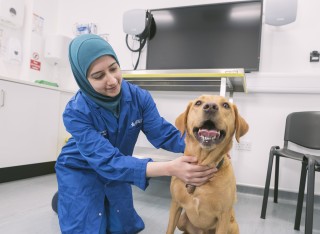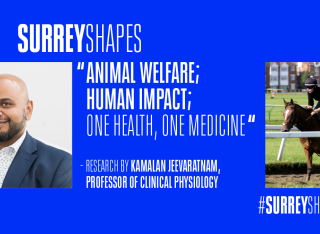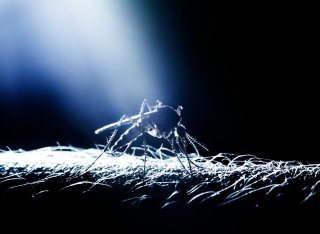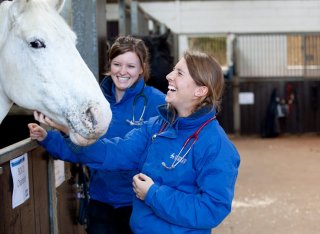
Professor Kamalan Jeevaratnam
About
Biography
Dr. Kamalan Jeevaratnam was previously the Royal College of Surgeons Ireland, Lead in Physiology at the School of Medicine, PU-RCSI based in Kuala Lumpur. As an academician, he has previously delivered anatomy and physiology lectures and practical session to both medical and veterinary students at the International Medical University, University Putra Malaysia and the University of Cambridge, UK. He is also an examiner on the surgical MRCS examinations.
His research interest includes integrative physiology, novel therapeutic agent discoveries, human animal interface research as well as medical education. His present work concerns the use integrative physiology techniques to elucidate mechanism of cardiac arrhythmia and developing risk stratification strategies for clinical practice. The work involves the identification and characterization of novel ion channel and receptor genes through functional analysis using gene-targeting to the invasive analysis of cardiac arrhythmia substrates in patients. He is actively involved in research collaboration with the University of Cambridge, UK; Xian Jiantong University, China; International Medical University, Malaysia; University Putra Malaysia, the Malaysian Agricultural Research and Development Institute and Animal Neighbours, Malaysia in the following areas: mechanisms of cardiac arrhythmia, biomarker discovery for gestational hypertension/preeclampsia, nutrigenomic trials and drug discovery for cognitive dysfunctions, and medical education research (PBLs and admission processes).
Dr. Jeevaratnam is also a keen public speaker, debater and judge, having previously debated for the prestigious Cambridge Union and been chief judge for several international debating competitions. He has been involved in the United Nations debate program as well as spoken as a youth leader on topics involving media and national development at the Perdana Leadership Foundation. His industry experience includes extensive work in training technical sales talent as well as developing key account management schemes in Malaysia for Colgate Palmolive's pet nutrition division, Hill's Pet Nutrition Incorp. He has previously consulted as a business development advisor for H&G Strategic Communication, based in Malaysia which specialises in executive training programs for private companies, local schools and universities. Prior to joining academia he was a companion animal clinician in Kuala Lumpur but after joining academia he sees cases at a primary care practice on weekends in the suburbs of Petaling Jaya.
Dr. Jeevaratnam holds a PhD from the University of Cambridge, a MMedSc from International Medical University and the Doctor of Veterinary Medicine from University Putra Malaysia, He was admitted to the Royal College of Veterinary Surgeons, UK in 2011 by examination. He was also the recipient of Merdeka Award Grant for International Attachment, the International Award by the Japanese Association of Laboratory Animal Sciences, the Nicola Emmerson Trust Award (2010-2011) the Cambridge Commonwealth Trust Award (2008-2010), Maxis Communications Scholarship for Excellence Program (2008-2011), and FFM Best Research Award (2005).
Research interests
1) Arrhythmogenic mechanisms in genetically modified murine hearts modelling metabolic syndrome associated with obesity and diabetes mellitus - Principal Investigator (funded by Ministry of Education, Malaysia) - commencing January 2015
2) Electrophysiological properties of cardiac myoctes derived from stem cells - Principal investigator (funded by the Merdeka Award Foundation) - commencing June 2015.
3) Isolation, prevalence and phylogenetic studies of multidrug resistant bacteria from canine and feline faeces residing in animal shelters - Co-Investigator (funded by Perdana University) - on-going
4) Advanced preclinical trial - assessment of a novel phytonutrient compound for anti-hypercholestreamic, anti-diabetic and neuroprotective effect - Principal investigator (funded by the Malaysian Agriculture Research and Development Institute and Academic Medical Centre) - on-going.
5) Characteristics of Medical Students Preparedness for Clinical Clerkship: Student and Supervisor Perspective - Co-Investigator (funded by International Medical University) - on-going.
News
Publications
Raw data from mass spectrometry on decellularised and deglycosylated murine atrial tissue. Data includes #PSM, #peptides and abundance values, amongst other variables.
The cardiac extracellular matrix (ECM) is involved in several pathological conditions, and age itself is also associated with certain changes in the heart: it gets larger and stiffer, and it develops an increased risk of abnormal intrinsic rhythm. This, therefore, makes conditions such as atrial arrythmia more common. Many of these changes are directly related to the ECM, yet the proteomic composition of the ECM and how it changes with age is not fully resolved. The limited research progress in this field is mainly due to the intrinsic challenges in unravelling tightly bound cardiac proteomic components and also the time-consuming and costly dependency on animal models. This review aims to give an overview of the composition of the cardiac ECM, how different components aid the function of the healthy heart, how the ECM is remodelled and how it is affected by ageing.
Background The alignment of student and workplace supervisors’ perspectives on student preparedness for veterinary workplace clinical training (WCT) is unknown, yet misalignment could negatively impact workplace learning. The aim of this study was to quantify the relative importance of WCT preparedness characteristics according to students and supervisors and to identify differences. Methods A survey was completed by 657 veterinary students and 244 clinical supervisors from 25 veterinary schools, from which rankings of the preparedness characteristics were derived. Significant rank differences were assessed using confidence intervals and permutation tests. Results ‘Honesty, integrity and dependability’ was the most important characteristic according to both groups. The three characteristics with the largest rank differences were: students’ awareness of their own and others’ mental wellbeing and the importance of self-care; being willing to try new practical skills with support (students ranked both of these higher); and having a clinical reasoning framework for common problems (supervisors ranked higher). Limitations Using pooled data from many schools means that the results are not necessarily representative of the perspectives at any one institution. Conclusion There are both similarities and differences in the perspectives of students and supervisors regarding which characteristics are more important for WCT. This provides insights that can be used by educators, curriculum developers and admissions tutors to improve student preparedness for workplace learning.
Learning theories are abstract descriptions which help us make sense of educational practice. Multiple theories can inform our understanding of a single concept, in this case: veterinary workplace clinical training (WCT), which occurs just prior to students' graduation as competent veterinary surgeons. The competency movement has strongly influenced reforms in veterinary education and is considered important. In reflection of this, the term “preparedness” is operationalised here as a measure of the likelihood that the veterinary student is going to be a competent learner and participant during WCT. Preparedness itself is therefore important because it directly impacts performance. Workplace clinical training is explored through the lenses of cognitivist, social constructivist and socio-culturalist learning theories and used to inform student preparedness characteristics (“tools”) in terms of their behaviours, personal attributes, knowledge and skills, and awarenesses to optimise learning and participation. These form a new conceptual framework—the “Preparedness Toolkit.”
Background Feline blood transfusion is required for the treatment of various illnesses in cats, and the safety of donor cats is vital. Donor adverse reactions can include cardiorespiratory, venepuncture-related, and behavioral abnormalities. Hypothesis/Objectives To describe a large number of feline blood donation events and document use of sedation and anxiolysis, record volume of blood collected and describe the frequency, type, and risk factors for, adverse reactions. Animals The study included 7812 individual cats and 29 201 donation events at a blood banking center over 5 years. Methods Retrospective analysis of donation event records with signalment, donation volume, sedation status, donation number, and adverse reactions (acute and caregiver reported) recorded. Risk factors for adverse reactions were examined by stratifying data according to groups exposed to relevant predictors and calculating odds ratios with 95% and 99% confidence intervals (CIs). Results Adverse reactions were uncommon (0.29%, 2.88/1000 donor events) and most commonly were cardiorespiratory (0.08%, 0.75/1000 donor events) or behavioral (0.06%, 0.62/1000 donor events). The only risk factor significantly associated with adverse reactions was conscious donation, with conscious donors 4.4 times more likely to have an adverse reaction (95% CI, 2.5-7.9, P ≤ .0001). Conclusions and Clinical Importance Feline blood donation is associated with a low rate of adverse reactions. Sedation should be considered to reduce adverse reactions, and the environment and interactions optimized to reduce donor stress. Caregiver education on care postdonation could reduce behavioral adverse reactions.
Hippocampal pyramidal neuronal activity has been previously studied using conventional patch clamp in isolated cells and brain slices. We here introduce the loose patch clamping study of voltage-activated currents from in situ pyramidal neurons in murine cornus ammonis 1 hippocampal coronal slices. Depolarizing pulses of 15-ms duration elicited early transient inward, followed by transient and prolonged outward currents in the readily identifiable junctional region between the stratum pyramidalis (SP) and oriens (SO) containing pyramidal cell somas and initial segments. These resembled pyramidal cell currents previously recorded using conventional patch clamp. Shortening the depolarizing pulses to >1-2 ms continued to evoke transient currents; hyperpolarizing pulses to varying voltages evoked decays whose time constants could be shortened to
Background: This study examined the clinical characteristics, genetic basis, healthcare utilisation and costs of catecholaminergic ven-tricular tachycardia (CPVT) patients from a Chinese city.Methods: This was a territory-wide retrospective cohort study of consecutive CPVT patients at public hospitals or clinics in Hong Kong. Healthcare resource utilisation for accident and emergency (A&E), in-patient and outpatient attendances were analysed over 19 years (2001-2019) followed by calculations of annualised costs (in USD).Results: Sixteen patients with a median presentation age (interquartile range (IQR) of 11 (9-14) years old) were included. Fifteen patients (93.8%) were initially symptomatic. Ten patients had both premature ventricular complexes (PVCs) and ventricular tachycar-dia/fibrillation (VT/VF). One patient had PVCs without VT/VF. Genetic tests were performed on 14 patients (87.5%). Eight (57.1%) tested positive for the ryanodine receptor 2 (RyR2) gene. Seven variants have been described elsewhere (c.14848G>A, c.12475C>A, c.7420A>G, c.11836G>A, c.14159T>C, c.10046C>T and c.7202G>A). c.14861C>G is a novel RyR2 variant not been reported out-side this cohort. Patients were treated with beta-blockers (n = 16), amiodarone (n = 3) and verapamil (n = 2). Sympathectomy (n = 8) and implantable-cardioverter defibrillator implantation (n = 3) were performed. Over a median follow-up of 13.3 years (IQR: 8.4-18.1) years, six patients exhibited incident VT/VF. At the patient level, the median (IQR) annualised costs for A&E, inpatient and outpatient attendances were $66 (40-95), $10521 (5240-66887) and $791 (546-1105), respectively.Conclusions: All patients presented before the age of 19. The yield of genetic testing was 57%. The most expensive attendance type was inpatient stays, followed by outpatients and A&E attendances.
Understanding the rules of life is one of the most important scientific endeavours and has revolutionised both biology and biotechnology. Remarkable advances in observation techniques allow us to investigate a broad range of complex and dynamic biological processes in which living systems could exploit quantum behaviour to enhance and regulate biological functions. Recent evidence suggests that these non-trivial quantum mechanical effects may play a crucial role in maintaining the non-equilibrium state of biomolecular systems. Quantum biology is the study of such quantum aspects of living systems. In this review, we summarise the latest progress in quantum biology, including the areas of enzyme-catalysed reactions, photosynthesis, spin-dependent reactions, DNA, fluorescent proteins, and ion channels. Many of these results are expected to be fundamental building blocks towards understanding the rules of life.
Brugada syndrome (BrS) is an ion channelopathy that predisposes affected patients to spontaneous ventricular tachycardia/fibrillation (VT/VF) and sudden cardiac death. The aim of this study is to examine the predictive factors of spontaneous VT/VF. This was a territory-wide retrospective cohort study of patients diagnosed with BrS between 1997 and 2019. The primary outcome was spontaneous VT/VF. Cox regression was used to identify significant risk predictors. Non-linear interactions between variables (latent patterns) were extracted using non-negative matrix factorisation (NMF) and used as inputs into the random survival forest (RSF) model. This study included 516 consecutive BrS patients (mean age of initial presentation=50±16 years, male=92%) with a median follow-up of 86 (IQR: 45-118) months. The cohort was divided into subgroups based on initial disease manifestation: asymptomatic (n=314), syncope (n=159) or VT/VF (n=41). Annualised event rates per person-year were 1.70%, 0.05% and 0.01% for the VT/VF, syncope and asymptomatic subgroups, respectively. Multivariate Cox regression analysis revealed initial presentation of VT/VF (HR=24.0, 95% CI=1.21 to 479, p=0.037) and SD of P-wave duration (HR=1.07, 95% CI=1.00 to 1.13, p=0.044) were significant predictors. The NMF-RSF showed the best predictive performance compared with RSF and Cox regression models (precision: 0.87 vs 0.83 vs. 0.76, recall: 0.89 vs. 0.85 vs 0.73, F1-score: 0.88 vs 0.84 vs 0.74). Clinical history, electrocardiographic markers and investigation results provide important information for risk stratification. Machine learning techniques using NMF and RSF significantly improves overall risk stratification performance.
Background Despite an increase in the use of online resources, their use by veterinary students, especially in the study of small animal internal medicine (SAIM), remains poorly understood. Methods A questionnaire-based study consisting of 26 survey items and 263 responses from seven UK universities investigated the use of online resources among clinical veterinary students studying SAIM and whether this was affected by age, gender, year of study or entry status. Results Random internet searches were the preferred method of clarifying queries, except for graduate-entry students and age categories 18-21 years and 28 years and over who preferred traditional textbooks. Online searches were preferred over emailing instructors or contacting instructors in person. Despite 73.3% of participants not automatically trusting information from online sources, only 47.1% fact-checked, although this was higher among the graduate-entry group (62.5%). Frequent social media use was reported; however, only 44.8% of students reported using social media to discuss SAIM. Video clip usage was high, and 82.9% of students reported video clips were useful for understanding SAIM concepts. Conclusion Online resources are a useful tool to complement traditional resources; however, a level of academic oversight may be required to ensure appropriate and effective use of these resources.
BACKGROUND: The Multiple Mini-Interview (MMI) has been used increasingly for selection of students to health professions programmes. OBJECTIVES: This paper reports on the evidence base for the feasibility, acceptability, reliability and validity of the MMI. DATA SOURCES: CINAHL and MEDLINE STUDY ELIGIBILITY CRITERIA: All studies testing the MMI on applicants to health professions training. STUDY APPRAISAL AND SYNTHESIS METHODS: Each paper was appraised by two reviewers. Narrative summary findings on feasibility, acceptability, reliability and validity are presented. RESULTS: Of the 64 citations identified, 30 were selected for review. The modal MMI consisted of 10 stations, each lasting eight minutes and assessed by one interviewer. The MMI was feasible, i.e. did not require more examiners, did not cost more, and interviews were completed over a short period of time. It was acceptable, i.e. fair, transparent, free from gender, cultural and socio-economic bias, and did not favour applicants with previous coaching. Its reliability was reported to be moderate to high, with Cronbach's alpha = 0.69-0.98 and G = 0.55-0.72. MMI scores did not correlate to traditional admission tools scores, were not associated with pre-entry academic qualifications, were the best predictor for OSCE performance and statistically predictive of subsequent performance at medical council examinations. CONCLUSIONS: The MMI is reliable, acceptable and feasible. The evidence base for its validity against future medical council exams is growing with reports from longitudinal investigations. However, further research is needed for its acceptability in different cultural context and validity against future clinical behaviours.
Background: Fragmented QRS (fQRS) results from myocardial scarring and predicts cardiovascular mortality and ventricular arrhythmia (VA). We evaluated the prevalence and prognostic value of fQRS in Asian patients hospitalized for heart failure.Methods and Results: This was a retrospective cohort study of adult patients hospitalized for heart failure between 1st January 2010 and 31st December 2016 at a tertiary center in Hong Kong. The baseline ECG was analyzed. QRS complexes (= 2 contiguous leads were defined as fQRS. The primary outcome was a composite of cardiovascular mortality, VA, and sudden cardiac death (SCD). The secondary outcomes were the components of the primary outcome, myocardial infarction, and new-onset atrial fibrillation. In total, 2,182 patients were included, of whom 179 (8.20%) had fQRS. The follow-up duration was 5.63 +/- 4.09 years. fQRS in any leads was associated with a higher risk of the primary outcome (adjusted hazard ratio (HR) 1.428 [1.097, 1.859], p = 0.001), but not myocardial infarction or new-onset atrial fibrillation. fQRS in >2 contiguous leads was an independent predictor of SCD (HR 2.679 [1.252, 5.729], p = 0.011). In patients without ischaemic heart disease (N = 1,396), fQRS in any leads remained predictive of VA and SCD (adjusted HR 3.526 [1.399, 8.887], p = 0.008, and 1.873 [1.103, 3.181], p = 0.020, respectively), but not cardiovascular mortality (adjusted HR 1.064 [0.671, 1.686], p = 0.792).Conclusion: fQRS is an independent predictor of cardiovascular mortality, VA, and SCD. Higher fQRS burden increased SCD risk. The implications of fQRS in heart failure patients without ischaemic heart disease require further studies.
The COVID-19 pandemic has required clinicians to urgently identify new treatment options or the re purposing of existing drugs. Of particular interest are chloroquine (CQ) and hydroxychloroquine (HCQ). The aims of this systematic review are to systematically identify and collate 24 studies describing the use of CQ and HCQ in human clinical trials and to provide a detailed synthesis of evidence of its efficacy and safety. Of clinical trials, 100% showed no significant difference in the probability of viral transmission or clearance in prophylaxis or therapy, respectively, compared to the control group. Among observational studies employing an endpoint specific to efficacy, 58% concurred with the finding of no significant difference in the attainment of outcomes. Three-fifths of clinical trials and half of observational studies examining an indicator unique to drug safety discovered a higher probability of adverse events in those treated patients suspected of, and diagnosed with, COVID-19. Of the total papers focusing on cardiac side effects, 44% found a greater incidence of QTc prolongation and/or arrhythmias, 44% found no evidence of a significant difference, and 11% mixed results. The strongest available evidence points towards the inefficacy of CQ and HCQ in prophylaxis or in the treatment of hospitalised COVID-19 patients. (c) 2020 The Author(s). Published by Elsevier B.V. on behalf of King Saud University. This is an open access article under the CC BY-NC-ND license (http://creativecommons.org/licenses/by-nc-nd/4.0/).
AIM: To test a hypothesis attributing arrhythmia in Brugada Syndrome to right ventricular (RV) outflow tract (RVOT) conduction abnormalities arising from Nav 1.5 insufficiency and fibrotic change. METHODS: Arrhythmic properties of Langendorff-perfused Scn5a+/- and wild-type mouse hearts were correlated with ventricular effective refractory periods (VERPs), multi-electrode array (MEA) measurements of action potential (AP) conduction velocities and dispersions in conduction direction (CD), Nav 1.5 expression levels, and fibrotic change, as measured at the RVOT and RV. Two-way anova was used to test for both independent and interacting effects of anatomical region and genotype on these parameters. RESULTS: Scn5a+/- hearts showed greater arrhythmic frequencies during programmed electrical stimulation at the RVOT but not the RV. The Scn5a+/- genotype caused an independent increase of VERP regardless of whether the recording site was the RVOT or RV. Effective AP conduction velocities (CV†s), derived from fitting regression planes to arrays of observed local activation times were reduced in Scn5a+/- hearts and at the RVOT independently. AP conduction velocity magnitudes derived by averaging MEA results from local vector analyses, CV*, were reduced by the Scn5a+/- genotype alone. In contrast, dispersions in conduction direction, were greater in the RVOT than the RV, when the atrioventricular node was used as the pacing site. The observed reductions in Nav 1.5 expression were attributable to Scn5a+/-, whereas increased levels of fibrosis were associated with the RVOT. CONCLUSIONS: The Scn5a+/- RVOT recapitulates clinical findings of increased arrhythmogenicity through reduced CV† reflecting reduced CV* attributable to reduced Nav 1.5 expression and increased CD attributable to fibrosis.
Introduction: Catecholaminergic polymorphic ventricular tachycardia (CPVT) is a rare inherited cardiac ion channelopathy. The present study aims to examine the clinical characteristics, genetic basis, and arrhythmic outcomes of CPVT patients from China to elucidate the difference between CPVT patients in Asia and Western countries. Methods: PubMed and Embase were systematically searched for case reports or series reporting on CPVT patients from China until 19 February 2022 using the keyword: “Catecholaminergic Polymorphic Ventricular Tachycardia” or “CPVT”, with the location limited to: “China” or “Hong Kong” or “Macau” in Embase, with no language or publication-type restriction. Articles that did not state a definite diagnosis of CPVT and articles with duplicate cases found in larger cohorts were excluded. All the included publications in this review were critically appraised based on the Joanna Briggs Institute Critical Appraisal Checklist. Clinical characteristics, genetic findings, and the primary outcome of spontaneous ventricular tachycardia/ventricular fibrillation (VT/VF) were analyzed. Results: A total of 58 unique cases from 15 studies (median presentation age: 8 (5.0–11.8) years old) were included. All patients, except one, presented at or before 19 years of age. There were 56 patients (96.6%) who were initially symptomatic. Premature ventricular complexes (PVCs) were present in 44 out of 51 patients (86.3%) and VT in 52 out of 58 patients (89.7%). Genetic tests were performed on 54 patients (93.1%) with a yield of 87%. RyR2, CASQ2, TERCL, and SCN10A mutations were found in 35 (71.4%), 12 (24.5%), 1 (0.02%) patient, and 1 patient (0.02%), respectively. There were 54 patients who were treated with beta-blockers, 8 received flecainide, 5 received amiodarone, 2 received verapamil and 2 received propafenone. Sympathectomy ( n = 10), implantable cardioverter-defibrillator implantation ( n = 8) and ablation ( n = 1) were performed. On follow-up, 13 patients developed VT/VF. Conclusion: This was the first systematic review of CPVT patients from China. Most patients had symptoms on initial presentation, with syncope as the presenting complaint. RyR2 mutation accounts for more than half of the CPVT cases, followed by CASQ2, TERCL and SCN10A mutations.
We explored for relationships between SCN5A haploinsufficiency, implicated in clinical arrhythmogenicity, and right ventricular (RV) conduction disorders in Langendorff-perfused, male and female, and young (3 months) and old (>12 month old) Scn5a ( +/-) and wild type (WT) hearts. The investigated conditions of genotype, age, and sex affected latencies but not repolarization time courses of RV monophasic action potentials. This prompted examination of the patterns of RV epicardial activation, its dispersion, and their interrelationships as possible arrhythmic mechanisms using a 64-channel, multi-electrode array. Mean ventricular activation times (T*(MEAN)), spatial dispersions (D* (S)) between recording channels/cardiac cycle, and maximum activation times (T* (MAX)) representing the slowest possible conduction in any given heart were all higher in old male Scn5a ( +/-) compared with young male and old female Scn5a ( +/-) and old male WT. Temporal dispersions (D*(T)) of recording channels were similarly higher in old male Scn5a (+/-) compared with old male WT. All groupings of D*(T), D*(S), and T*(MAX) nevertheless linearly correlated with T*(MEAN), with indistinguishable slopes. The variates explored thus influence D*(T), D*(S), and T*(MAX) through actions on T*(MEAN). These findings in turn correlated with increased levels of fibrosis in young male, young female, and old male Scn5a ( +/-) compared with the corresponding WTs. We thus demonstrate for the first time independent and interacting effects of genotype, age, and sex on epicardial conduction and its dispersions at least partially attributable to fibrotic change, resulting in the greatest effects in old male Scn5a ( +/-) in an absence of alterations in repolarization time courses. This directly implicates altered depolarization in the clinical arrhythmogenicity associated with Scn5a ( +/-).
1. In the present study, we investigated the effect of age on atrial electrophysiological properties in Scn5a(+/-) hearts used to model corresponding increases in atrial arrhythmic tendency in human Brugada syndrome. 2. Atrial action potential initiation, propagation and recovery were compared in young (3 month old) and aged (12 month old), wild-type (WT) and Scn5a(+/-) hearts. Multielectrode array recordings assessed the spatial propagation of intrinsic electrical activity in superfused atrial preparations, whereas bipolar electrogram recordings measured basic cycle lengths (BCL) in Langendorff preparations. The duration of electrogram activity (EGD) during regular and extrasystolic stimulation with programmed electrical stimulation provided EGD ratios and atrial effective refractory periods (AERP). Monophasic recordings measured action potential durations (APD). 3. Systematic statistical explorations for independent and interacting effects of age and the Scn5a(+/-) condition demonstrated that both young and aged Scn5a(+/-) mice exhibited slowed propagation of atrial excitation relative to corresponding WT mice, with the greatest effects in aged Scn5a(+/-) mice, which additionally exhibited increased intrinsic BCL. 4. Young Scn5a(+/-) mice exhibited greater EGD and EGD ratios, as well as APD/AERP ratios, suggesting increased arrhythmic tendency compared with WT mice. 5. Aged Scn5a(+/-) mice exhibited normal EGD, EGD ratios and APD compared to aged WT and young Scn5a(+/-), and increased AERP and smaller APD/AERP ratios compared with young Scn5a(+/-). 6. These electrophysiological findings indicate increased atrial arrhythmogenicity with maximal effects on both conduction and repolarization characteristics in young compared with aged Scn5a(+/-) mice.
Over the past years, there has been increasing awareness on female representation in cardiology, in particular senior academic ranks. Given the gender disparity in cardiology, female talents in cardiovascular academic medicine are significantly under-represented. In addition, whilst women have a slightly higher frequency of earning first authorships, it has been reported that women are 50% less likely to hold a senior authorship position. The drop in female representation in senior ranks of academic medicine may be contributed by a lack of female talent engagement, particularly during their early-career advancement, in high-impact journals and leadership roles. We present a remote, accessible-distributed research team model to help raise the female representation and tackle the challenges faced by female academics in the field of cardiovascular medicine. The group celebrates accessibility through open communication and collaboration, where mentees can seek research advice and ideas virtually from senior members and principal investigators. The decentralized system allows easy access for research guidance and inspirationand break down barriers in the lack of mentorship for early-career female talents. Students are empowered to lead their projects, and be involved in all phases- from the generation of study ideas to publication. The early development of holistic independent research skills equips students to become principal investigators and leaders in the future. The distributive element of the group is demonstrated through the decentralized research approach employed. Authorship is allocated based on intellectual contribution rather than on the acquisition of funding or seniority level.
Background Life-threatening arrhythmias resulting from genetic mutations are often missed in current electrocardiogram (ECG) analysis. We combined a new method for ECG analysis that uses all the waveform data with machine learning to improve detection of such mutations from short ECG signals in a mouse model. Objective We sought to detect consequences of Na+ channel deficiencies known to compromise action potential conduction in comparisons of Scn5a+/- mutant and wild-type mice using short ECG signals, examining novel and standard features derived from lead I and II ECG recordings by machine learning algorithms. Methods Lead I and II ECG signals from anesthetized wild-type and Scn5a+/- mutant mice of length 130 seconds were analyzed by extracting various groups of features, which were used by machine learning to classify the mice as wild-type or mutant. The features used were standard ECG intervals and amplitudes, as well as features derived from attractors generated using the novel Symmetric Projection Attractor Reconstruction method, which reformulates the whole signal as a bounded, symmetric 2-dimensional attractor. All the features were also combined as a single feature group. Results Classification of genotype using the attractor features gave higher accuracy than using either the ECG intervals or the intervals and amplitudes. However, the highest accuracy (96%) was obtained using all the features. Accuracies for different subgroups of the data were obtained and compared. Conclusion Detection of the Scn5a+/- mutation from short mouse ECG signals with high accuracy is possible using our Symmetric Projection Attractor Reconstruction method.
Introduction The present study evaluated the application of incorporating non-linear J/U-shaped relationships between mean HbA1c and cholesterol levels into risk scores for predicting acute myocardial infarction (AMI) and non-AMI-related sudden cardiac death (SCD) respectively, amongst patients with type 2 diabetes mellitus. Methods This was a territory-wide cohort study of patients with type 2 diabetes mellitus above the age 40 and free from prior AMI and SCD, with or without prescriptions of anti-diabetic agents between January 1st, 2009 to December 31st, 2009 at government-funded hospitals and clinics in Hong Kong. Patients recruited were followed up until 31 December 2019 or their date of death. Risk scores were developed for predicting incident AMI and non-AMI-related SCD. The performance of conditional inference survival forest (CISF) model compared to that of random survival forests (RSF) model and multivariate Cox model. Results This study included 261 308 patients (age = 66.0 +/- 11.8 years old, male = 47.6%, follow-up duration = 3552 +/- 1201 days, diabetes duration = 4.77 +/- 2.29 years). Mean HbA1c and low high-density lipoprotein-cholesterol (HDL-C) were significant predictors of AMI on multivariate Cox regression. Mean HbA1c was linearly associated with AMI, whilst HDL-C was inversely associated with AMI. Mean HbA1c and total cholesterol were significant multivariate predictors with a J-shaped relationship with non-AMI-related SCD. The AMI and SCD risk scores had an area under the curve (AUC) of 0.666 (95% confidence interval (CI) = [0.662, 0.669]) and 0.677 (95% CI = [0.673, 0.682]), respectively. CISF significantly improves prediction performance of both outcomes compared to RSF and multivariate Cox models. Conclusion A holistic combination of demographic, clinical and laboratory indices can be used for the risk stratification of patients with type 2 diabetes mellitus for AMI and SCD.
The aim of this work is to distinguish between wild-type mice and Scn5a +/- mutant mice using short ECG signals. This mutation results in impaired cardiac sodium channel function and is associated with increased ventricular arrhythmogenic risk which can result in sudden cardiac death. Lead I and Lead II ECG signals from wild-type and Scn5a +/- mice are used and the mice are also grouped as female/male and young/old.We use our novel Symmetric Projection Attractor Reconstruction (SPAR) method to generate an attractor from the ECG signal using all of the available waveform data. We have previously manually extracted a variety of quantitative measures from the attractor and used machine learning to classify each animal as either wild-type or mutant. In this work, we take the attractor images and use these as input to a deep learning algorithm in order to perform the same classification. As there is only data available from 42 mice, we use a transfer learning approach in which a network that has been pretrained on millions of images is used as a starting point and the last few layers are changed in order to fine tune the network for the attractor images.The results for the transfer learning approach are not as good as for the manual features, which is not too surprising as the networks have not been trained on attractor images. However, this approach shows the potential for using deep learning for classification of attractor images.
Introduction Long QT syndrome (LQTS) is a less prevalent cardiac ion channelopathy than Brugada syndrome in Asia. The present study compared the outcomes between paediatric/young and adult LQTS patients. Methods This was a population-based retrospective cohort study of consecutive patients diagnosed with LQTS attending public hospitals in Hong Kong. The primary outcome was spontaneous ventricular tachycardia/ventricular fibrillation (VT/VF). Results A total of 142 LQTS (mean onset age=27 +/- 23 years old) were included. Arrhythmias other than VT/VF (HR 4.67, 95% CI (1.53 to 14.3), p=0.007), initial VT/VF (HR=3.25 (95% CI 1.29 to 8.16), p=0.012) and Schwartz score (HR=1.90 (95% CI 1.11 to 3.26), p=0.020) were predictive of the primary outcome for the overall cohort, while arrhythmias other than VT/VF (HR=5.41 (95% CI 1.36 to 21.4), p=0.016) and Schwartz score (HR=4.67 (95% CI 1.48 to 14.7), p=0.009) were predictive for the adult subgroup (>25 years old; n=58). A random survival forest model identified initial VT/VF, Schwartz score, initial QTc interval, family history of LOTS, initially asymptomatic and arrhythmias other than VT/VF as the most important variables for risk prediction. Conclusion Clinical and ECG presentation varies between the paediatric/young and adult LQTS population. Machine learning models achieved more accurate VT/VF prediction.
AIMS: The experiments explored for atrial arrhythmogenesis and its possible physiological background in recently developed hetero-(RyR2(+/S)) and homozygotic (RyR2(S/S)) RyR2-P2328S murine models for catecholaminergic polymorphic ventricular tachycardia (VT) for the first time. They complement previous clinical and experimental reports describing increased ventricular arrhythmic tendencies associated with physical activity, stress, or catecholamine infusion, potentially leading to VT and ventricular fibrillation. METHODS AND RESULTS: Atrial arrhythmogenic properties were compared at the whole animal, Langendorff-perfused heart, and single, isolated atrial myocyte levels using electrophysiological and confocal fluorescence microscopy methods. This demonstrated that: (i) electrocardiographic parameters in intact anaesthetized wild-type (WT), RyR2(+/S) and RyR2(S/S) mice were statistically indistinguishable both before and after addition of isoproterenol apart from increases in heart rates. (ii) Bipolar electrogram and monophasic action potential recordings showed significantly higher incidences of arrhythmogenesis in isolated perfused RyR2(S/S), but not RyR2(+/S), relative to WT hearts during either regular pacing or programmed electrical stimulation. The addition of isoproterenol increased such incidences in all three groups. (iii) However, there were no accompanying differences in cardiac anatomy or action potential durations at 90% repolarization and refractory periods. (iv) In contrast, episodes of diastolic Ca(2+) release were observed under confocal microscopy in isolated fluo-3-loaded RyR2(S/S), but not RyR2(+/S) or WT, atrial myocytes. The introduction of isoproterenol resulted in significant diastolic Ca(2+) release in all three groups. CONCLUSIONS: These findings establish acute atrial arrhythmogenic properties in RyR2-P2328S hearts and correlate these with altered Ca(2+) homeostasis in an absence of repolarization abnormalities for the first time.
Potassium is the predominant intracellular cation, with its extracellular concentrations maintained between 3. 5 and 5 mM. Among the different potassium disorders, hypokalaemia is a common clinical condition that increases the risk of life-threatening ventricular arrhythmias. This review aims to consolidate pre-clinical findings on the electrophysiological mechanisms underlying hypokalaemia-induced arrhythmogenicity. Both triggers and substrates are required for the induction and maintenance of ventricular arrhythmias. Triggered activity can arise from either early afterdepolarizations (EADs) or delayed afterdepolarizations (DADs). Action potential duration (APD) prolongation can predispose to EADs, whereas intracellular Ca 2+ overload can cause both EADs and DADs. Substrates on the other hand can either be static or dynamic. Static substrates include action potential triangulation, non-uniform APD prolongation, abnormal transmural repolarization gradients, reduced conduction velocity (CV), shortened effective refractory period (ERP), reduced excitation wavelength (CV × ERP) and increased critical intervals for re-excitation (APD–ERP). In contrast, dynamic substrates comprise increased amplitude of APD alternans, steeper APD restitution gradients, transient reversal of transmural repolarization gradients and impaired depolarization-repolarization coupling. The following review article will summarize the molecular mechanisms that generate these electrophysiological abnormalities and subsequent arrhythmogenesis.
The long QT syndrome (LQTS) is largely treated pharmacologically with β‐blockers, despite the role of sympathetic activity in LQTS being poorly understood. Using the trigger–substrate model of cardiac arrhythmias in this review, we amalgamate current experimental and clinical data from both animal and human studies to explain the mechanism of adrenergic stimulation and blockade on LQT arrhythmic risk and hence assess the efficacy of β‐adrenoceptor blockade in the management of LQTS. In LQTS1 and LQTS2, sympathetic stimulation increases arrhythmic risk by enhancing early afterdepolarizations and transmural dispersion of repolarization. β‐Blockers successfully reduce cardiac events by reducing these triggers and substrates; however, these effects are less marked in LQTS2 compared with LQTS1. In LQTS3, clinical and experimental investigations of the effects of sympathetic stimulation and β‐blocker use have produced contradictory findings, resulting in significant clinical uncertainty. We offer explanations for these contradicting results relating to study sample size, the dose of the β‐blocker administered associated with its off‐target Na+ channel effects, as well as the type of β‐blocker used. We conclude that the antiarrhythmic efficacy of β‐blockers is a genotype‐specific phenomenon, and hence the use of β‐blockers in clinical practice should be genotype dependent. Our review amalgamates current experimental and clinical data from both animal and human studies to explain the mechanism of adrenergic stimulation and blockade on LQT arrhythmic risk and hence assess the efficacy of β‐adrenoceptor blockade in the management of LQTS.
The EU-CardioRNA Cooperation in Science and Technology (COST) Action is a European-wide consortium established in 2018 with 31 European country members and four associate member countries to build bridges between translational researchers from academia and industry who conduct research on non-coding RNAs, cardiovascular diseases and similar research areas. EU-CardioRNA comprises four core working groups (WG1-4). In the first year since its launch, EU-CardioRNA met biannually to exchange and discuss recent findings in related fields of scientific research, with scientific sessions broadly divided up according to WG. These meetings are also an opportunity to establish interdisciplinary discussion groups, brainstorm ideas and make plans to apply for joint research grants and conduct other scientific activities, including knowledge transfer. Following its launch in Brussels in 2018, three WG meetings have taken place. The first of these in Lisbon, Portugal, the second in Istanbul, Turkey, and the most recent in Maastricht, The Netherlands. Each meeting includes a scientific session from each WG. This meeting report briefly describes the highlights and key take-home messages from each WG session in this first successful year of the EU-CardioRNA COST Action.
BACKGROUND: Hypertensive disorders in pregnancy contributes to about 12% of maternal deaths in Malaysia and similarly worldwide. Early detection and adequate management are preventable strategies. Biochemical markers of abnormal angiogenesis would be more specific in early detection than routine blood pressure and proteinuria measurements. The aim of this study was to estimate maternal plasma PlGF and sFlt-1 levels in pregnant women with gestational hypertension at three intervals of pregnancy and correlate these biomarker levels with placental morphometry. METHODS: Venous blood samples (antepartum, intrapartum and post partum periods) were drawn to estimate for sFlt-1 and PlGF levels while placental tissue samples were examined for placental morphometry. RESULTS: PlGF levels were lower in gestational hypertension (GH) compared to normotensive during antepartum and intrapartum period, whereas sFlt-1 levels were elevated in GH at antepartum, intrapartum and postpartum intervals during pregnancy. An inverse relationship between these two biomarkers was observed through correlation analysis. PlGF levels were inversely correlated with total villous surface area of the placental periphery (TCsa-C) and villous capillarization (VC-C) of the placental periphery. CONCLUSION: We established periodic values of for sFlt-1 and PlGF levels for the first time in an ethnically diverse Malaysian setting. We suggest the development of GH in women is related to defective capillarization. In demonstrating periodic changes, this study suggest the possibility of developing GH and other long term health complications as a result of prolonged exposure to sFlt-1. The correlation between PlGF levels and morphometric findings also support possible capillarization defect.
The foundation of dielectrophoresis (DEP) as a tool for biological investigation is the use of the Clausius–Mossotti (C–M) factor to model the observed behaviour of cells experiencing DEP across a frequency range. Nevertheless, it is also the case that at lower frequencies, the DEP spectrum deviates from predictions; there exists a rise in DEP polarisability, which varies in frequency and magnitude with different cell types and medium conductivities. In order to evaluate the origin of this effect, we have studied DEP spectra from five cell types (erythrocytes, platelets, neurons, HeLa cancer cells and monocytes) in several conditions including medium conductivity and cell treatment. Our results suggest the effect manifests as a low‐pass dispersion whose cut‐off frequency varies with membrane conductance and capacitance as determined using the DEP spectrum; the effect also varies as a logarithm of medium conductivity and Debye length. These together suggest that the values of membrane capacitance and conductance depend not only on the impedance of the membrane itself, but also of the surrounding double layer. The amplitude of the effect in different cell types compared to the C–M factor was found to correlate with the depolarisation factors for the cells’ shapes, suggesting that this ratio may be useful as an indicator of cell shape for DEP modelling.
Malaria remains the leading cause of parasitic death in the world. Artemisinin resistance is an emerging threat indicating an imminent need for novel combination therapy. Given the key role of mass drug administration, it is pivotal that the safety of anti-malarial drugs is investigated thoroughly prior to widespread use. Cardiotoxicity, most prominently arrhythmic risk, has been a concern for anti-malarial drugs. We clarify the likely underlying mechanisms by which anti-malarial drugs predispose to arrhythmias. These relate to disruption of (1) action potential upstroke due to effects on the sodium currents, (2) action potential repolarisation due to effects on the potassium currents, (3) cellular calcium homeostasis, (4) mitochondrial function and reactive oxygen species production and (5) cardiac fibrosis. Together, these alterations promote arrhythmic triggers and substrates. Understanding these mechanisms is essential to assess the safety of these drugs, stratify patients based on arrhythmic risk and guide future anti-malarial drug development.
Simple Summary The Covid-19 pandemic has significantly impacted the provision of veterinary education. The principal challenges and mitigating approaches have focussed on the delivery of material online, but given the practical and professional outcomes required of veterinary graduates, innovative ways to provide some in person teaching have been sought also. The public health implications of the Covid-19 pandemic have caused unprecedented and unexpected challenges for veterinary schools worldwide. They are grappling with a wide range of issues to ensure that students can be trained and assessed appropriately, despite the international, national, and local restrictions placed on them. Moving the delivery of knowledge content largely online will have had a positive and/or negative impact on veterinary student learning gain which is yet to be clarified. Workplace learning is particularly problematic in the current climate, which is concerning for graduates who need to develop, and then demonstrate, practical core competences. Means to optimise the learning outcomes in a hybrid model of curriculum delivery are suggested. Specific approaches could include the use of video, group discussion, simulation and role play, peer to peer and interprofessional education.
Mitochondrial dysfunction underlying metabolic disorders such as obesity and diabetes mellitus is strongly associated with cardiac arrhythmias. Murine Pgc-1 alpha(& minus;/& minus;)& nbsp;hearts replicate disrupted mitochondrial function and model the associated pro-arrhythmic electrophysiological abnormalities. Quantitative PCR, western blotting and histological analysis were used to investigate the molecular basis of the electrophysiological changes associated with mitochondrial dysfunction. qPCR analysis implicated downregulation of genes related to Na+-K+& nbsp;ATPase activity (Atp1b1), surface Ca2+& nbsp;entry (Cacna1c), action potential & nbsp;repolarisation & nbsp;(Kcnn1), autonomic function (Adra1d, Adcy4, Pde4d, Prkar2a), and morphological properties (Myh6, Tbx3) in murine Pgc-1 alpha(& minus;/& minus;)& nbsp;ventricles. Western blotting revealed reduced Na(V)1.5 but normal Cx43 expression. Histological analysis revealed increased tissue fibrosis in the Pgc-1 alpha(& minus;/& minus;)& nbsp;ventricles. These present findings identify altered transcription amongst a strategically selected set of genes established as encoding proteins involved in cardiac electrophysiological activation and therefore potentially involved in alterations in ventricular activation and Ca2+& nbsp;homeostasis & nbsp;in arrhythmic substrate associated with Pgc-1 alpha deficiency. They complement and complete previous studies examining such expression characteristics in the atria and ventricles of Pgc-1 deficient murine hearts.
Catecholaminergic polymorphic ventricular tachycardia (CPVT) is associated with mutations in the cardiac ryanodine receptor (RyR2). These result in stress-induced ventricular arrhythmic episodes, with clinical symptoms and prognosis reported more severe in male than female patients. Murine homozygotic RyR2-P2328S (RyR2 ) hearts replicate the proarrhythmic CPVT phenotype of abnormal sarcoplasmic reticular Ca leak and disrupted Ca homeostasis. In addition, RyR2 hearts show decreased myocardial action potential conduction velocities (CV), all features implicated in arrhythmic trigger and substrate. The present studies explored for independent and interacting effects of RyR2 genotype and sex on expression levels of molecular determinants of Ca homeostasis (CASQ2, FKBP12, SERCA2a, NCX1, and Ca 1.2) and CV (Na 1.5, Connexin (Cx)-43, phosphorylated-Cx43, and TGF-β1) in mice. Expression levels of Ca homeostasis proteins were not altered, hence implicating abnormal RyR2 function alone in disrupted cytosolic Ca homeostasis. Furthermore, altered Na 1.5, phosphorylated Cx43, and TGF-β1 expression were not implicated in the development of slowed CV. By contrast, decreased Cx43 expression correlated with slowed CV, in female, but not male, RyR2 mice. The CV changes may reflect acute actions of the increased cytosolic Ca on Na 1.5 and Cx43 function.
INTRODUCTION: The familial condition catecholaminergic polymorphic ventricular tachycardia (CPVT) is characterized by episodic bidirectional ventricular tachycardia (BVT), polymorphic ventricular tachycardia (PVT), and ventricular fibrillation following adrenergic challenge. It is associated with mutations involving the cardiac ryanodine receptor (RyR2). METHODS AND RESULTS: We explored for a slowing of myocardial conduction that could potentially result in a substrate for the spontaneous arrhythmogenesis that was observed following introduction of isoproterenol and caffeine in intrinsically beating murine RyR2-P2328S hearts. Such pharmacological challenge increased the number of arrhythmic episodes in electrocardiographic recordings from intact anesthetized mice, with the greatest effects in the homozygote RyR2(S/S). Arrhythmias took the form of bigeminy, BVT, monomorphic ventricular tachycardia, and PVT, as found in human CPVT. Ventricular epicardial conduction velocities (CVs) measured using multielectrode array recordings and maximum action potential upstroke rates, (dV/dt)(max), measured using intracellular microelectrodes were indistinguishable in untreated wild-type (WT) and RyR2(S/S). Pharmacological challenge of RyR2(S/S), but not WT hearts, then reduced CV and (dV/dt)(max) and also revealed a strongly arrhythmic phenotype. There was no evidence of gross structural or fibrotic changes in either RyR2(+/S) or RyR2(S/S) hearts on light microscopy. CONCLUSIONS: We associate altered ventricular myocardial CV potentially resulting in arrhythmogenic substrate with arrhythmic properties associated with genetic RyR2 alterations for the first time.
The analysis of an electrocardiogram (ECG) is able to provide vital information on the electrical activity of the heart and is crucial for the accurate diagnosis of cardiac arrhythmias. Due to the nature of some arrhythmias, this might be a time-consuming and difficult to accomplish process. The advent of novel machine learning technologies in this field has a potential to revolutionise the use of the ECG. In this review, we outline key advances in ECG analysis for atrial, ventricular and complex multiformarrhythmias, as well as discuss the current limitations of the technology and the barriers that must be overcome before clinical integration is feasible. (c) 2019 Elsevier Inc. All rights reserved.
While the increased arrhythmic tendency during acute COVID-19 infection is recognised, the long-term cardiac electrophysiological complications are less well known. There are a high number of patients reporting ongoing symptoms post-infection, termed long COVID. A recent hypothesis is that long COVID symptoms could be attributed to dysautonomia, defined as malfunction of the autonomic nervous system (ANS). The most prevalent cardiovascular dysautonomia amongst young people is postural orthostatic tachycardia syndrome (POTS). Numerous reports have described the development of POTS as part of long COVID. Possible underlying mechanisms, although not mutually exclusive or exhaustive, include hypovolaemia, neurotropism, inflammation and autoimmunity. Treatment options for POTS and other long COVID symptoms are currently limited. Future research studies should aim to elucidate the underlying mechanisms of dysautonomia to enable the development of targeted therapies. Furthermore, it is important to educate healthcare professionals to recognise complications and conditions arising from COVID-19, such as POTS, to allow prompt diagnosis and access to early treatment.
Recent studies have reported that human mutations in Nav1.5 predispose to early age onset atrial arrhythmia. The present experiments accordingly assess atrial arrhythmogenicity in aging Scn5a+/KPQ mice modeling long QT3 syndrome in relationship to cardiac Na(+) channel, Nav1.5, expression. Atrial electrophysiological properties in isolated Langendorff-perfused hearts from 3- and 12-month-old wild type (WT), and Scn5a+/KPQ mice were assessed using programmed electrical stimulation and their Nav1.5 expression assessed by Western blot. Cardiac conduction properties were assessed electrocardiographically in intact anesthetized animals. Monophasic action potential recordings demonstrated increased atrial arrhythmogenicity specifically in aged Scn5a+/DeltaKPQ hearts. These showed greater action potential duration/refractory period ratios but lower atrial Nav1.5 expression levels than aged WT mice. Atrial Nav1.5 levels were higher in young Scn5a+/DeltaKPQ than young WT. These levels increased with age in WT but not Scn5a+/DeltaKPQ. Both young and aged Scn5a+/DeltaKPQ mice showed lower heart rates and longer PR intervals than their WT counterparts. Young Scn5a+/DeltaKPQ mice showed longer QT and QTc intervals than young WT. Aged Scn5a+/DeltaKPQ showed longer QRS durations than aged WT. PR intervals were prolonged and QT intervals were shortened in young relative to aged WT. In contrast, ECG parameters were similar between young and aged Scn5a+/DeltaKPQ. Aged murine Scn5a+/DeltaKPQ hearts thus exhibit an increased atrial arrhythmogenicity. The differing Nav1.5 expression and electrocardiographic indicators of slowed cardiac conduction between Scn5a+/DeltaKPQ and WT, which show further variations associated with aging, may contribute toward atrial arrhythmia in aged Scn5a+/DeltaKPQ hearts.
Both Brugada Syndrome (BrS) and progressive cardiac conduction defect (PCCD) are associated respectively with diffuse and discrete alterations in conduction pathways affected by ageing and sex. This study assessed for contributions of such processes to the mechanism of conduction changes in Scn5a(+/-) and WT hearts stratified by age (3 and 12 months) and sex. In vivo electrocardiographic chest-lead assessment demonstrated greater incidences of bundle branch block in all Scn5a(+/-) mice compared to WT. Frequency analysis of right ventricular (RV) epicardial activation obtained from a 64-channel multi-electrode array demonstrated greater prominence of late conducting components in Scn5a(+/-) compared to WT male, and in male compared to female Scn5a(+/-) following stratification by genotype and sex. Similar differences were observed between old male Scn5a(+/-) and young male Scn5a(+/-), old female Scn5a(+/-), and old male WT, following stratification by genotype, age and sex. These findings directly correlated with histomorphometric assessment of regional fibrosis in both septa and free walls preferentially involving the RV. We demonstrate complex alterations in conduction distributions suggesting a conversion of normal to slow-conducting tissue, modulated by ageing and sex, coupled with fibrosis in Scn5a(+/-) hearts. These features suggest an overlap between pathophysiological processes related to BrS and PCCD in Scn5a(+/-) hearts.
The vertebrate nervous system is divided into central (CNS) and peripheral (PNS) components. In turn, the PNS is divided into the autonomic (ANS) and enteric (ENS) nervous systems. Ageing implicates time-related changes to anatomy and physiology in reducing organismal fitness. In the case of the CNS, there exists substantial experimental evidence of the effects of age on individual neuronal and glial function. Although many such changes have yet to be experimentally observed in the PNS, there is considerable evidence of the role of ageing in the decline of ANS function over time. As such, this chapter will argue that the ANS constitutes a paradigm for the physiological consequences of ageing, as well as for their clinical implications.
Online resources are becoming increasingly important in undergraduate education and have been associated with a number of advantages and positive outcomes on students' learning experience. However, online resource use by veterinary students for physiology learning remains poorly understood. Thus the present questionnaire-based study aims to investigate the extent to which first- and second-year veterinary students use online resources, including online video clips and social media, in their physiology learning and if this is influenced by factors of age, gender, entry status, or year of study. One-hundred and twenty-two students across seven UK universities completed the survey. Traditional resources (the lecturer and recommended textbooks) were the most preferred sources for physiology learning. Nonetheless, 97.5% of students used Internet search engines to explore physiology topics. Furthermore, students' tendency to contact their instructor regarding a physiology question was low. Rather, 92.6% said they would first search for an answer online. Particularly popular was the use of online video clips with 91.1% finding them valuable for physiology learning and 34.21% finding them more useful for understanding physiology than university taught material or lecture slides. YouTube was the most common online video clip platform used by students. Most students stated that they would enjoy interacting with course materials on an instructor-led social media page, but only 33.9% currently use social media to discuss physiology-related issues with classmates. Additionally, most students expressed concerns regarding the reliability of online resources but attempts to fact-check these resources were relatively low. Therefore, online resources represent an essential part of veterinary students' physiology learning and this suggests that educators can significantly improve student engagement and understanding of physiology by integrating these resources.
Understanding health care resource utilisation and its associated costs are important for identifying areas of improvement regarding resource allocations. However, there is limited research exploring this issue in the setting of Brugada syndrome (BrS).This was a retrospective territory-wide study of BrS patients from Hong Kong. Healthcare resource utilisation for accident and emergency (A&E), inpatient and specialist outpatient attendances were analyzed over a 19-year period, with their associated costs presented in US dollars. A total of 507 BrS patients with a mean presentation age of 49.9 ± 16.3 years old were included. Of these, 384 patients displayed spontaneous type 1 electrocardiographic (ECG) Brugada pattern and 77 patients had presented with ventricular tachycardia/ventricular fibrillation (VT/VF). At the individual patient level, the median annualized costs were $110 (52-224) at the (A&E) setting, $6812 (1982-32414) at the inpatient setting and $557 (326-1001) for specialist outpatient attendances. Patients with initial VT/VF presentation had overall greater costs in inpatient ($20161 [9147-189215] vs $5290 [1613-24937],P < 0.0001) and specialist outpatient setting ($776 [438-1076] vs $542 [293-972],P = 0.015) compared to those who did not present VT. In addition, patients without Type 1 ECG pattern had greater median costs in the specialist outpatient setting ($7036 [3136-14378] vs $4895 [2409-10554],p=0.019). There is a greater health care demand in the inpatient and specialist outpatient settings for BrS patients. The most expensive attendance type was inpatient setting stay at $6812 per year. The total median annualized cost of BrS patients without VT/VF presentation was 78% lower compared to patients with VT/VF presentation.
Sigma-1 receptors are ligand-regulated chaperone proteins, involved in several cellular mechanisms. The aim of this systematic review was to examine the effects that the sigma-1 receptor has on the cardiovascular system. The interaction targets and proposed mechanisms of action of sigma-1 receptors were explored, with the aim of determining if the sigma-1 receptor is a potential pharmacological target for cardiac pathologies. This systematic review was conducted according to the PRISMA guidelines and these were used to critically appraise eligible studies. Pubmed and Scopus were systematically searched for articles investigating sigma-1 receptors in the cardiovascular system. Papers identified by the search terms were then subject to analysis against pre-determined inclusion criteria. 23 manuscripts met the inclusion criteria and were included in this review. The experimental platforms, experimental techniques utilised and the results of the studies were summarised. The sigma-1 receptor is found to be implicated in cardioprotection, via various mechanisms including stimulating the Akt-eNOS pathway, and reduction of Ca2+ leakage into the cytosol via modulating certain calcium channels. Sigma-1 receptors are also found to modulate other cardiac ion channels including different subtypes of potassium and sodium channels and have been shown to modulate intracardiac neuron excitability. The sigma-1 receptor is a potential therapeutic target for treatment of cardiac pathologies, particularly cardiac hypertrophy. We therefore suggest investigating the cardioprotective mechanisms of sigma-1 receptor function, alongside proposed potential ligands that can stimulate these functions.
AIM: To investigate the interacting effects of age and sex on electrocardiographic (ECG) features of Scn5a(+/-) mice modelling Brugada syndrome. METHODS: Recordings were performed on anaesthetized wild-type (WT) and Scn5a(+/-) mice and differences attributable to these risk factors statistically stratified. RESULTS: Scn5a(+/-) exerted sex-dependent effects upon sino-atrial function that only became apparent with age. RR intervals were greater in old male than in old female Scn5a(+/-). Atrio-ventricular (AV) conduction was slower in young female mice, whether WT and Scn5a(+/-), than the corresponding young male WT and Scn5a(+/-). However, PR intervals lengthened with age in male but not in female Scn5a(+/-) giving the greatest PR intervals in old male Scn5a(+/-) compared with either old male WT or young male Scn5a(+/-) mice. In contrast, PR intervals were similar in old female Scn5a(+/-) and in old female WT. QTc was prolonged in Scn5a(+/-) compared with WT, and female Scn5a(+/-) compared with female WT. Age-dependent alterations in durations of ventricular repolarization relative to WT affected male but not female Scn5a(+/-). Thus, T-wave durations were greater in old male Scn5a(+/-) compared with old male WT, but indistinguishable between old female Scn5a(+/-) and old female WT. Finally, analysis for combined interactions of genotype, age and sex demonstrated no effects on P wave and QRS durations and QTc intervals. CONCLUSION: We demonstrate for the first time that age, sex and genotype exert both independent and interacting ECG effects. The latter suggest alterations in cardiac pacemaker function, atrio-ventricular conduction and ventricular repolarization greatest in ageing male Scn5a(+/-).
Metabolic abnormalities may exacerbate the risk of adverse outcomes in patients with type 2 diabetes mellitus. The present study aims to assess the predictive value of HbA1c and lipid variability on the risks of sudden cardiac death (SCD) and incident atrial fibrillation (AF). The retrospective observational study consists of type 2 diabetic patients prescribed with insulin, who went to publicly funded clinics and hospitals in Hong Kong between January 1, 2009 and December 31, 2009. Variability in total cholesterol, low-density lipoprotein-cholesterol (LDL-C), high-density lipoprotein-cholesterol (HDL-C), triglyceride, and HbA1c were assessed through their SD and coefficient of variation. The primary outcomes were incident (1) ventricular tachycardia/ventricular fibrillation, actual or aborted SCD and (2) AF. A total of 23 329 patients (mean ± SD age: 64 ± 14 years old; 51% male; mean HbA1c 8.6 ± 1.3%) were included. On multivariable analysis, HbA1c, total cholesterol, LDL-C and triglyceride variability were found to be predictors of SCD (p
To compare the effects of sodium-glucose cotransporter 2 inhibitors (SGLT2Is) and dipeptidyl peptidase-4 inhibitors (DPP4Is) on adverse outcomes in diabetic patients in Hong Kong. This was a retrospective population-based cohort study of type 2 diabetes mellitus patients (n = 72,746) treated with SGLT2I or DPP4I between January 1, 2015, and December 31, 2020, in Hong Kong. Patients with exposure to both DPP4I and SGLT2I therapy, without complete demographics or mortality data, or who had prior atrial fibrillation (AF) were excluded. The study outcomes were new-onset AF, stroke/transient ischemic attack, cardiovascular mortality and all-cause mortality. Propensity score matching (1:1 ratio) between SGLT2I and DPP4I users was performed. The unmatched study cohort included 21,713 SGLT2I users and 39,510 DPP4I users (total: n = 61,233 patients; 55.37% males, median age: 62.7 years [interquartile range (IQR): 54.6-71.9 years]). Over a median follow-up of 2030 (IQR: 1912-2117) days, 2496 patients (incidence rate [IR]: 4.07%) developed new-onset AF, 2179 patients (IR: 3.55%) developed stroke/transient ischemic attack, 1963 (IR: 3.20%) died from cardiovascular causes and 6607 patients (IR: 10.79%) suffered from all-cause mortality. After propensity score matching (SGLT2I: n = 21,713; DPP4I: n = 21,713), SGLT2I users showed lower incidence of new-onset AF (1.96% vs. 2.78%, standardized mean difference [SMD] = 0.05), stroke (1.80% vs. 3.52%, SMD = 0.11), cardiovascular mortality (0.47% vs. 1.56%, SMD = 0.11) and all-cause mortality (2.59% vs. 7.47%, SMD = 0.22) compared to DPP4I users. Cox regression found that SGLT2I users showed lower risk of new-onset AF (hazard ratio [HR]: 0.68, 95% confidence interval [CI]: [0.56, 0.83], P = 0.0001), stroke (HR: 0.64, 95% CI: [0.53, 0.79], P
Cardiac arrhythmias constitute a major public health problem. Pharmacological intervention remains mainstay to their clinical management. This, in turn, depends upon systematic drug classification schemes relating their molecular, cellular, and systems effects to clinical indications and therapeutic actions. This approach was first pioneered in the 1960s Vaughan-Williams classification. Subsequent progress in cardiac electrophysiological understanding led to a lag between the fundamental science and its clinical translation, partly addressed by The working group of the European Society of Cardiology (1991), which, however, did not emerge with formal classifications. We here utilize the recent Revised Oxford Classification Scheme to review antiarrhythmic drug pharmacology. We survey drugs and therapeutic targets offered by the more recently characterized ion channels, transporters, receptors, intracellular Ca2+ handling, and cell signaling molecules. These are organized into their strategic roles in cardiac electrophysiological function. Following analysis of the arrhythmic process itself, we consider (a) pharmacological agents directly targeting membrane function, particularly the Na+ and K+ ion channels underlying depolarizing and repolarizing events in the cardiac action potential. (b) We also consider agents that modify autonomic activity that, in turn, affects both the membrane and (c) the Ca2+ homeostatic and excitation-contraction coupling processes linking membrane excitation to contractile activation. Finally, we consider (d) drugs acting on more upstream energetic and structural remodeling processes currently the subject of clinical trials. Such systematic correlations of drug actions and arrhythmic mechanisms at different molecular to systems levels of cardiac function will facilitate current and future antiarrhythmic therapy.
Background The rise of nature-based ecotourism in the past decade has introduced unprecedented challenges in managing the increasing interaction between humans and animals. The potential transmission of antibiotic resistant microbes between humans and non-human primate populations is a concern due to their genetic similarity. Malaysia is well known for hotspots of wildlife diversity where non-human primates like monkeys and orangutans have become popular tourist attractions. In this study, we assessed the prevalence of antimicrobial resistant Staphylococcus aureus, Enterococcus species, and other Enterobacteriaceae in the faeces of human (HS) and two non-human primates (NHP) in Malaysia, the Long-tailed macaque (Macaca fascicularis, MF) and Silvered leaf monkey (Trachypithecus cristatus, TC). In addition, the faecal bacterial composition was profiled to evaluate the potential association between antibiotic resistant profiles and composition of gut microbiota. Results We tested the isolated bacteria using a selection of antibiotics. The results showed that both the number of antibiotic resistant strains and resistance level were higher in humans than NHPs. Overall, the composition of gut microbiome and pattern of antibiotic resistance showed that there was higher similarity between MF and TC, the two NHPs, than with HS. In addition, samples with higher levels of antibiotic resistance showed lower bacterial richness. Homo sapiens had the lowest bacterial diversity and yet it had higher abundance of Bacteroides. In contrast, NHPs displayed higher bacterial richness and greater prevalence of Firmicutes such as Ruminococceae and Oscillospira. Conclusion Higher antibiotic susceptibility in NHPs is likely related to low direct exposure to antibiotics. The lack of resistance may also suggest limited antimicrobial resistance transmission between humans and NHP. Nonetheless, continued monitoring over a long period will help mitigate the risk of anthropozoonosis and zooanthroponosis.
Background In the wake of the controversy surrounding the SYMPLICITY HTN-3 trial and data from subsequent trials, this review aims to perform an updated and more comprehensive review of the impact of renal sympathetic denervation on cardiac arrhythmias. Methods and results A systematic search was performed using the Medline, Scopus and Embase databases using the terms "Renal Denervation" AND "Arrhythmias or Atrial or Ventricular", limited to Human and English language studies within the last 10 years. This search yielded 19 relevant studies (n = 6 randomised controlled trials, n = 13 non-randomised cohort studies) which comprised 783 patients. The studies show RSD is a safe procedure, not associated with increases in complications or mortality post-procedure. Importantly, there is no evidence RSD is associated with a deterioration in renal function, even in patients with chronic kidney disease. RSD with or without adjunctive pulmonary vein isolation (PVI) is associated with improvements in freedom from atrial fibrillation (AF), premature atrial complexes (PACs), ventricular arrhythmias and other echocardiographic parameters. Significant reductions in ambulatory and office blood pressure were also observed in the majority of studies. Conclusion This review provides evidence based on original research that 'second generation' RSD is safe and is associated with reductions in short-term blood pressure and AF burden. However, the authors cannot draw firm conclusions with regards to less prominent arrhythmia subtypes due to the paucity of evidence available. Large multi-centre RCTs investigating the role of RSD are necessary to comprehensively assess the efficacy of the procedure treating various arrhythmias.
We hypothesized that an interpretable gradient boosting machine (GBM) model considering comorbidities, P-wave and echocardiographic measurements, can better predict mortality and cerebrovascular events in mitral regurgitation (MR). Patients from a tertiary center were analyzed. The GBM model was used as an interpretable statistical approach to identify the leading indicators of high-risk patients with either outcome of CVAs and all-cause mortality. A total of 706 patients were included. GBM analysis showed that age, systolic blood pressure, diastolic blood pressure, plasma albumin levels, mean P-wave duration (PWD), MR regurgitant volume, left ventricular ejection fraction (LVEF), left atrial dimension at end-systole (LADs), velocity-time integral (VTI) and effective regurgitant orifice were significant predictors of TIA/stroke. Age, sodium, urea and albumin levels, platelet count, mean PWD, LVEF, LADs, left ventricular dimension at end systole (LVDs) and VTI were significant predictors of all-cause mortality. The GBM demonstrates the best predictive performance in terms of precision, sensitivity c-statistic and F1-score compared to logistic regression, decision tree, random forest, support vector machine, and artificial neural networks. Gradient boosting model incorporating clinical data from different investigative modalities significantly improves risk prediction performance and identify key indicators for outcome prediction in MR.
AIM: QT interval prolongation reflecting delayed action potential (AP) repolarization is associated with polymorphic ventricular tachycardia and early after depolarizations potentially initiating extrasystolic APs if of sufficient amplitude. The current experiments explored contributions of altered re-excitation thresholds for, and conduction of, such extrasystolic APs to arrhythmogenesis in Langendorff-perfused, normokalaemic, control wild-type hearts and two experimental groups modelling long QT (LQT). The two LQT groups consisted of genetically modified, Scn5a(+/ΔKPQ) and hypokalaemic wild-type murine hearts. METHODS: Hearts were paced from their right ventricles and monophasic AP electrode recordings obtained from their left ventricular epicardia, with recording and pacing electrodes separated by 1 cm. An adaptive programmed electrical stimulation protocol applied pacing (S1) stimulus trains followed by premature (S2) extrastimuli whose amplitudes were progressively increased with progressive decrements in S1S2 interval to maintain stimulus capture. Such protocols culminated in either arrhythmic or refractory endpoints. RESULTS: Arrhythmic outcomes were associated with (1) lower conduction velocities in their initiating extrasystolic APs than refractory outcomes and (2) higher conduction velocities in the LQT groups than in controls. Furthermore, (3) the endpoints were reached at longer S1S2 coupling intervals and with smaller stimulus amplitudes in the LQT groups compared with controls. This was despite (4) similar relationships between conduction velocity and S1S2 coupling interval and between re-excitation thresholds and S1S2 coupling interval in all three experimental groups. CONCLUSIONS: Arrhythmias induced by extrasystolic APs in the LQT groups thus occur under conditions of higher conduction velocity and greater sensitivity to extrastimuli than in controls.
Bisphosphonates (BPs) are widely prescribed drugs used to treat osteoporosis, commonly arising in postmenopausal women and in chronic glucocorticoid use. Their mechanism of action is through inhibiting osteoclast-induced bone remodeling, and they also possess calcium sequestering properties. Common side effects involve the gastrointestinal system and rare but serious side effects, including osteonecrosis of the jaw. However, a link between BPs and atrial fibrillation (AF) has been proposed, with early clinical trials, such as the Fracture Intervention Trial and the HORIZON Pivotal Fracture Trial, reporting that BPs are associated with increased risk of AF. Nevertheless, subsequent studies have reported contrasting results, ranging from no effect of BPs to antiarrhythmic effects of BPs. Preclinical and electrophysiological studies on any proarrhythmic effect of BPs are limited in scope and number, but suggest possible mechanisms that include antiangionesis-related myocardial remodeling, calcium handling abnormalities, and inflammatory changes. Contrastingly, some studies indicate that BPs are antiarrhythmic by inhibiting fibrotic myocardial remodeling. In order to continue established clinical prescribing of BPs within absolute margins of safety, it will be necessary to systematically rule in/rule out these mechanisms. Thus, we discuss these studies and examine in detail the potential mechanistic links, with the aim of suggesting further avenues for research.
Coronary artery disease (CAD) is the leading cause of sudden cardiac death in adults, and new methods of predicting disease and risk-stratifying patients will help guide intervention in order to reduce this burden. Current CAD detection involves multiple modalities, but the consideration of other biomarkers will help improve reliability. The aim of this narrative review is to help researchers and clinicians appreciate the growing relevance of miRNA in CAD and its potential as a biomarker, and also to suggest useful miRNA that may be targets for future study. We sourced information from several databases, namely PubMed, Scopus, and Google Scholar, when collating evidentiary information. MicroRNAs (miRNA) are short, noncoding RNAs that are relevant in cardiovascular physiology and pathophysiology, playing roles in cardiac hypertrophy, maintenance of vascular tone, and responses to vascular injury. CAD is associated with changes in miRNA expression profiles, and so are its risk factors, such as abnormal lipid metabolism and inflammation. Thus, they may potentially be biomarkers of CAD. Nevertheless, there are limitations in using miRNA. These include cost and the presence of several confounding factors that may affect miRNA profiles. Furthermore, there is difficulty in the normalisation of miRNA values between published studies, due to pre-analytical variations in samples.
Total serum bilirubin concentration (TBIL) can provide useful information on several pathophysiological conditions in cats. Nevertheless, whether the variable severity classification of hyperbilirubinemia can reliably indicate certain disease processes or predict a biliary obstruction (BO) has not been investigated. Determine if hyperbilirubinemia of variable severity can assist clinicians to identify BO, which often is considered a surgical emergency. Two-hundred sixteen client-owned cats. Data were retrospectively collected from all cats (January 2015-August 2022) with an increased TBIL (>0.58 mg/dL [>10 μmol/L]) presented to 3 referral centers in the United Kingdom (UK). Presenting clinical features and diagnostic outcomes were collected. The predictive ability of TBIL to indicate BO was evaluated by multivariable binary logistic regression modeling and receiver operating characteristic (ROC) curves. Median TBIL was 1.73 mg/dL (range, 0.59-26.15; 29.5 μmol/L; range, 10.1-447.1) with severity classification of hyperbilirubinemia categorized as mild (>0.58-2.92 mg/dL; >10-50 μmol/L; 68.1%), moderate (>2.92-5.85 mg/dL; >50-100 μmol/L; 17.6%), severe (>5.85-11.70 mg/dL; >100-200 μmol/L; 9.7%) and very severe (>11.70 mg/dL; >200 μmol/L; 4.6%). Biliary obstruction was present in 17 (7.9%) cats, all of which received recommendation for emergency surgery. Median TBIL in cats with BO (9.69 mg/dL; 165.7 μmol/L) differed significantly from those without obstruction (1.51 mg/dL; 25.8 μmol/L; P
Electrical conductivity is of great significance to cardiac tissue engineering and permits the use of electrical stimulation in mimicking cardiac pacing. The development of biomaterials for tissue engineering can incorporate physical properties that are uncommon to standard cell culture and can facilitate improved cardiomyocyte function. In this review, the PICOT question asks, "How has the application of external electrical stimulation in conductive scaffolds for tissue engineering affected cardiomyocyte behavior in in vitro cell culture?" The Preferred Reporting Items for Systematic Reviews and Meta-Analysis guidelines, with predetermined inclusion and quality appraisal criteria, were used to assess publications from PubMed, Web of Science, and Scopus. Results revealed carbon nanotubes to be the most common conductive agent in biomaterials and rodent-sourced cell types as the most common cardiomyocytes used. To assess cardiomyocytes, immunofluorescence was used most often, utilizing proteins, such as connexin 43, cardiac α-actinin, and cardiac troponins. It was determined that the modal average stimulation protocol comprised 1-3 V square biphasic 50-ms pulses at 1 Hz, applied toward the end of cell culture. The addition of electrical stimulation to in vitro culture has exemplified it as a powerful tool for cardiac tissue engineering and brings researchers closer to creating optimal artificial cardiac tissue constructs.
Aims Frailty may be found in heart failure patients especially in the elderly and is associated with a poor prognosis. However, assessment of frailty status is time-consuming, and the electronic frailty indices developed using health records have served as useful surrogates. We hypothesized that an electronic frailty index developed using machine learning can improve short-term mortality prediction in patients with heart failure. Methods and results This was a retrospective observational study that included patients admitted to nine public hospitals for heart failure from Hong Kong between 2013 and 2017. Age, sex, variables in the modified frailty index, Deyo's Charlson co-morbidity index (>= 2), neutrophil-to-lymphocyte ratio (NLR), and prognostic nutritional index at baseline were analysed. Gradient boosting, which is a supervised sequential ensemble learning algorithm with weak prediction submodels (typically decision trees), was applied to predict mortality. Variables were ranked in the order of importance with a total score of 100 and used to build the frailty models. Comparisons were made with decision tree and multivariable logistic regression. A total of 8893 patients (median: age 81, Q1-Q3: 71-87 years old) were included, in whom 9% had 30 day mortality and 17% had 90 day mortality. Prognostic nutritional index, age, and NLR were the most important variables predicting 30 day mortality (importance score: 37.4, 32.1, and 20.5, respectively) and 90 day mortality (importance score: 35.3, 36.3, and 14.6, respectively). Gradient boosting significantly outperformed decision tree and multivariable logistic regression. The area under the curve from a five-fold cross validation was 0.90 for gradient boosting and 0.87 and 0.86 for decision tree and logistic regression in predicting 30 day mortality. For the prediction of 90 day mortality, the area under the curve was 0.92, 0.89, and 0.86 for gradient boosting, decision tree, and logistic regression, respectively. Conclusions The electronic frailty index based on co-morbidities, inflammation, and nutrition information can readily predict mortality outcomes. Their predictive performances were significantly improved by gradient boosting techniques.
Introduction Patients with diabetes mellitus are risk of premature death. In this study, we developed a machine learning-driven predictive risk model for all-cause mortality among patients with type 2 diabetes mellitus using multiparametric approach with data from different domains. Research design and methods This study used territory-wide data of patients with type 2 diabetes attending public hospitals or their associated ambulatory/outpatient facilities in Hong Kong between January 1, 2009 and December 31, 2009. The primary outcome is all-cause mortality. The association of risk variables and all-cause mortality was assessed using Cox proportional hazards models. Machine and deep learning approaches were used to improve overall survival prediction and were evaluated with fivefold cross validation method. Results A total of 273 678 patients (mean age: 65.4 +/- 12.7 years, male: 48.2%, median follow-up: 142 (IQR=106142) months) were included, with 91 155 deaths occurring on follow-up (33.3%; annualized mortality rate: 3.4%/year; 2.7 million patient-years). Multivariate Cox regression found the following significant predictors of all-cause mortality: age, male gender, baseline comorbidities, anemia, mean values of neutrophil-to-lymphocyte ratio, high-density lipoprotein-cholesterol, total cholesterol, triglyceride, HbA1c and fasting blood glucose (FBG), measures of variability of both HbA1c and FBG. The above parameters were incorporated into a score-based predictive risk model that had a c-statistic of 0.73 (95% CI 0.66 to 0.77), which was improved to 0.86 (0.81 to 0.90) and 0.87 (0.84 to 0.91) using random survival forests and deep survival learning models, respectively. Conclusions A multiparametric model incorporating variables from different domains predicted all-cause mortality accurately in type 2 diabetes mellitus. The predictive and modeling capabilities of machine/deep learning survival analysis achieved more accurate predictions.
AIMS: Recent studies reported slowed conduction velocity (CV) in murine hearts homozygous for the gain-of-function RyR2-P2328S mutation (RyR2(S/S)) and associated this with an increased incidence of atrial and ventricular arrhythmias. The present experiments determined mechanisms contributing to the reduced atrial CV. METHODS AND RESULTS: The determinants of CV were investigated in murine RyR2(S/S) hearts and compared with those in wild-type (WT) and slow-conducting Scn5a(+/-) hearts. Picrosirius red staining demonstrated increased fibrosis only in Scn5a(+/-) hearts. Immunoblot assays showed similar expressions of Cx43 and Cx40 levels in the three genotypes. In contrast, Nav1.5 expression was reduced in both RyR2(S/S) and Scn5a(+/-) atria. These findings correlated with intracellular microelectrode and loose-patch-clamp studies. Microelectrode measurements showed reduced maximum rates of depolarization in Scn5a(+/-) and RyR2(S/S) atria compared with WT, despite similar diastolic membrane potentials. Loose-patch-clamp measurements demonstrated reduced peak Na(+) currents (INa) in the Scn5a(+/-) and RyR2(S/S) atria relative to WT, with similar normalized current-voltage relationships. In WT atria, reduction in INa could be produced by treatment with high extracellular Ca(2+), caffeine, or cyclopiazonic acid, each expected to produce an acute increase in [Ca(2+)]i. CONCLUSION: RyR2(S/S) atria show reduced levels of Nav1.5 expression and Na(+) channel function. Reduced Na(+) channel function was also observed in WT atria, following acute increases in [Ca(2+)]i. Taken together, the results suggest that raised [Ca(2+)]i produces both acute and chronic inhibition of Na(+) channel function. These findings may help explain the relationship between altered Ca(2+) homeostasis, CV, and the maintenance of common arrhythmias such as atrial fibrillation.
The Scn5a gene encodes the major pore-forming Na 1.5 (α) subunit, of the voltage-gated Na channel in cardiomyocytes. The key role of Na 1.5 in action potential initiation and propagation in both atria and ventricles predisposes organisms lacking Scn5a or carrying Scn5a mutations to cardiac arrhythmogenesis. Loss-of-function Na 1.5 genetic abnormalities account for many cases of the human arrhythmic disorder Brugada syndrome (BrS) and related conduction disorders. A murine model with a heterozygous Scn5a deletion recapitulates many electrophysiological phenotypes of BrS. This study examines the relationships between its Scn5a genotype, resulting transcriptional changes, and the consequent phenotypic presentations of BrS. Of 62 selected protein-coding genes related to cardiomyocyte electrophysiological or homeostatic function, concentrations of mRNA transcribed from 15 differed significantly from wild type (WT). Despite halving apparent ventricular Scn5a transcription heterozygous deletion did not significantly downregulate its atrial expression, raising possibilities of atria-specific feedback mechanisms. Most of the remaining 14 genes whose expression differed significantly between WT and Scn5a animals involved Ca homeostasis specifically in atrial tissue, with no overlap with any ventricular changes. All statistically significant changes in expression were upregulations in the atria and downregulations in the ventricles. This investigation demonstrates the value of future experiments exploring for and clarifying links between transcriptional control of Scn5a and of genes whose protein products coordinate Ca regulation and examining their possible roles in BrS.
Skeletal and cardiac muscle excitation–contraction coupling commences with Nav1.4/Nav1.5-mediated, surface and transverse (T-) tubular, action potential generation. This initiates feedforward, allosteric or Ca2+-mediated, T-sarcoplasmic reticular (SR) junctional, voltage sensor-Cav1.1/Cav1.2 and ryanodine receptor-RyR1/RyR2 interaction. We review recent structural, physiological and translational studies on possible feedback actions of the resulting SR Ca2+ release on Nav1.4/Nav1.5 function in native muscle. Finite-element modelling predicted potentially regulatory T-SR junctional [Ca2+]TSR domains. Nav1.4/Nav1.5, III-IV linker and C-terminal domain structures included Ca2+ and/or calmodulin-binding sites whose mutations corresponded to specific clinical conditions. Loose-patch-clamped native murine skeletal muscle fibres and cardiomyocytes showed reduced Na+ currents (INa) following SR Ca2+ release induced by the Epac and direct RyR1/RyR2 activators, 8-(4-chlorophenylthio)adenosine-3′,5′-cyclic monophosphate and caffeine, abrogated by the RyR inhibitor dantrolene. Conversely, dantrolene and the Ca2+-ATPase inhibitor cyclopiazonic acid increased INa. Experimental, catecholaminergic polymorphic ventricular tachycardic RyR2-P2328S and metabolically deficient Pgc1β−/− cardiomyocytes also showed reduced INa accompanying [Ca2+]i abnormalities rescued by dantrolene- and flecainide-mediated RyR block. Finally, hydroxychloroquine challenge implicated action potential (AP) prolongation in slowing AP conduction through modifying Ca2+ transients. The corresponding tissue/organ preparations each showed pro-arrhythmic, slowed AP upstrokes and conduction velocities. We finally extend discussion of possible Ca2+-mediated effects to further, Ca2+, K+ and Cl−, channel types. This article is part of the theme issue ‘The heartbeat: its molecular basis and physiological mechanisms’.
The SCN.511 gene encodes Na(v)1.5, which, as the cardiac voltage-gated Na+ channel's pore-forming a subunit, is crucial for the initiation and propagation of atrial and ventricular action potentials. The arrhythmogenic propensity of inherited SCN5A mutations implicates the Na+ channel in determining cardiomyocyte excitability under normal conditions. Cytosolic kinases have long been known to alter the kinetic profile of Na(v)1.5 inactivation via phosphorylation of specific residues. Recent substantiation of both the role of calmodulin-dependent kinase II (CaMKII) in modulating the properties of the Na(v)1.5 inactivation gate and the significant rise in oxidation-dependent autonomous CaMKII activity in structural heart disease has raised the possibility of a novel pathway for acquired arrhythmias - the CaMKII-Na(v)1.5 relationship. The aim of this review is to: (1) outline the relationship's translation from physiological adaptation to pathological vicious circle; and (2) discuss the relative merits of each of its components as pharmacological targets.
The development of novel drugs specifically directed at the ion channels underlying particular features of cardiac action potential (AP) initiation, recovery, and refractoriness would contribute to an optimized approach to antiarrhythmic therapy that minimizes potential cardiac and extracardiac toxicity. Of these, Kþ channels contribute numerous and diverse currents with specific actions on different phases in the time course of AP repolarization. These features and their site-specific distribution make particular Kþ channel types attractive therapeutic targets for the development of pharmacological agents attempting antiarrhythmic therapy in conditions such as atrial fibrillation. However, progress in the development of such temporally and spatially selective antiarrhythmic drugs against particular ion channels has been relatively limited, particularly in view of our incomplete understanding of the complex physiological roles and interactions of the various ionic currents. This review summarizes the physiological properties of the main cardiac potassium channels and the way in which they modulate cardiac electrical activity and then critiques a number of available potential antiarrhythmic drugs directed at them.
Recent papers have attributed arrhythmic substrate in murine RyR2-P2328S hearts to reduced action potential (AP) conduction velocities (CV), reflecting acute functional inhibition and/or reduced expression of sodium channels. We explored for acute effects of direct Epac (exchange protein directly activated by cAMP)-mediated ryanodine receptor-2 (RyR2) activation on arrhythmic substrate and CV. Monophasic action potential recordings demonstrated that initial steady (8-Hz) extrinsic pacing elicited ventricular tachycardia (VT) in 0 of 18 Langendorff-perfused wild-type mouse ventricles before pharmacological intervention. The Epac activator 8-CPT (8-(4-chlorophenylthio)-2'-O-methyladenosine-3',5'-cyclic monophosphate) (VT in 1 of 7 hearts), and the RyR2 blocker dantrolene, either alone (0 of 11) or with 8-CPT (0 of 9) did not then increase VT incidence (p>0.05). Both progressively increased pacing rates and programmed extrasystolic (S2) stimuli similarly produced no VT in untreated hearts (n = 20 and n = 9 respectively). 8-CPT challenge then increased VT incidences (5 of 7 and 4 of 8 hearts respectively; p0.05). 8-CPT but not dantrolene, whether alone or combined with 8-CPT, correspondingly increased AP latencies (1.14±0.04 (n=7), 1.04±0.03 (n=10), 1.09±0.05 (n=8) relative to respective control values). In contrast, AP durations, conditions for 2:1 conduction block and ventricular effective refractory periods remained unchanged throughout. We thus demonstrate for the first time that acute RyR2 activation reversibly induces VT in specific association with reduced CV.
Long QT Syndrome 3 (LQTS3) arises from gain-of-function Nav1.5 mutations, prolonging action potential repolarisation and electrocardiographic (ECG) QT interval, associated with increased agedependent risk for major arrhythmic events, and paradoxical responses to β-adrenergic agents. We investigated for independent and interacting efects of age and Scn5a+/ΔKPQ genotype in anaesthetised mice modelling LQTS3 on ECG phenotypes before and following β-agonist challenge, and upon fbrotic change. Prolonged ventricular recovery was independently associated with Scn5a+/ΔKPQ and age. Ventricular activation was prolonged in old Scn5a+/ΔKPQ mice (p=0.03). We associated Scn5a+/ΔKPQ with increased atrial and ventricular fbrosis (both: p















